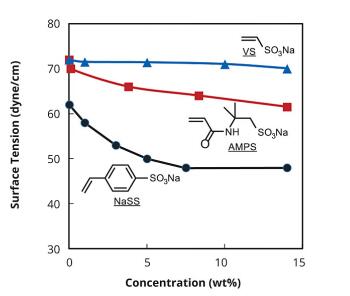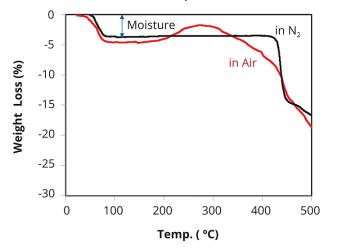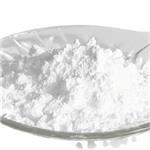The application and character of sodium p-styrenesulfonate
Mar 3,2020
Reaction Performance of Sodium p-styrenesulfonate
Sodium p-styrenesulfonate (NaSS) is a functional monomer having a radical polymerizable vinyl group, a hydrophobic benzene ring having π electrons, and a sulfonic acid (salt) group that is a strong electrolyte and has been valued in various industrial fields. NaSS is white wet powder at room temperature as shown in figure 1[1].
With the inductive effect of sulfo radical on the para position against vinyl group, sodium p-styrenesulfonate (NaSS) possesses the highest reactivity (polymerization activity) among all sulfonated vinyl monomers. It performs radical polymerization in such polar solvents as DMF, DMSO and water using common or redox polymerization initiators. For example, it has been used as a reactive emulsifier in order to improve stability of an emulsion and water resistance or cationic dye dyeability of a (emulsion) polymer. Further, a polymer or a copolymer of sodium p-styrenesulfonate has been used as a dispersant for producing various aqueous dispersions of pigments, antioxidants, various polymers (tackifier resins, chloroprene rubber, polyacrylic acid esters, polyesters, styrene-butadiene copolymers, polyvinyl chloride, poly-acrylonitrile, polysilicones, conductive polymers and the like), nanocarbon materials, silica particles for hot forging release agents or abrasives, battery electrode materials (carbon, lithium iron phosphate, lithium manganese phosphate and the like), photographic silver halides and the like. Furthermore, the polymer of sodium p-styrenesulfonate has been utilized as synthetic starch for clothing finishing such as an ironing agent, a hair care product, an antistatic agent, a resist acid generator, a water treatment agent, an allergen scavenger, an ion-exchange resin, a plating solution additive, a detergent for production of semiconductors and hard disks, an additive to fluids for shale oil drilling and a flame retardant for resins [2].

Figure 1 The appearance of NaSS
Application of Nass
NaSS is a water-soluble monomer manufactured via a bromine intermediate (Scheme 1). The most attractive properties of NaSS are good surface activity (Figure 2), thermal stability (Figure 3) and radical polymerizability (Table 1). The principal use of NaSS is producing acrylic fiber by emulsion polymerization. As referred at above, PolyNaSS, is the NaSS monomer polymerized, and has excellent thermal stability, transparency and dispersing power, so it has been used as a finishing agent for clothes, dispersants, anti-statics, separation membranes, scale inhibitors and oil field chemicals etc.

Scheme 1 Production route of NaSS

Figure 2 Surface tension of sulfonated monomer aq. (Wilhelmy Method, Pt-Plate)

Figure 3 TG-DTA analysis of NaSS (10 ºC/min.)

Table 1 Q and e values of various monomers
So NaSS would be an ideal monomer for emulsion polymerization of acrylate due to its excellent polymerizability and surface activity. Covalently introduced sulfonate moieties would remarkably enhance the colloidal stability (Figure 4).

Figure 4 Schematic drawings of emulsion particle
In the synthesized polymers, NaSS showed the best performance in terms of mechanical stability, foaming and water absorption. This was attributed to the good polymerizability and surface activity of NaSS. But there is still room for improvement, especially water resistance [3].
Referneces
[1] https://www.tosohusa.com/products--services/sodium-styrenesulfonate
[2] Ozoe, Shinji et, al., US 20150246876A1, HIGH-PURITY SODIUM P-STYRENESULFONATE WITH EXCELLENT HUE, METHOD FOR PRODUCING THE SAME, POLY (SODIUM P-STYRENESULFONATE) WITH EXCELLENT HUE USING THE SAME, AND DISPERSANT AND SYNTHETIC STARCH FOR CLOTHING FINISHING USING THE POLY ( SODIUM P-STYRENESULFONATE)
[3] https://www.pcimag.com/articles/106311-styrene-sulfonate
- Related articles
- Related Qustion
Clobetasol propionate was patented in 1968 and came into medical use in 1978. It is available as a generic medication. Clobetasol propionate is used for the treatment of various skin disorders including eczema.....
Mar 3,2020API2-Phenylimidazole (2-PI) is used to prepare complex compounds with ruthenium (III) and also as an intermediate for agrochemical, pharmaceutical and specialty products. It also finds its application as a curing agent for epoxy resins.....
Mar 3,2020Catalyst and AuxiliarySodium p-styrenesulfonate
2695-37-6You may like
Sodium p-styrenesulfonate manufacturers
- Sodium p-styrenesulfonate
-

- $10.00 / 1kg
- 2024-05-29
- CAS:2695-37-6
- Min. Order: 1kg
- Purity: 99%
- Supply Ability: 20ton
- Sodium p-styrenesulfonate
-

- $0.00 / 1kg
- 2024-05-27
- CAS:2695-37-6
- Min. Order: 1kg
- Purity: 99%
- Supply Ability: 500000kg
- Sodium p-styrenesulfonate
-

- $6.00 / 1KG
- 2024-05-08
- CAS:2695-37-6
- Min. Order: 1KG
- Purity: 99%
- Supply Ability: 20TONS




